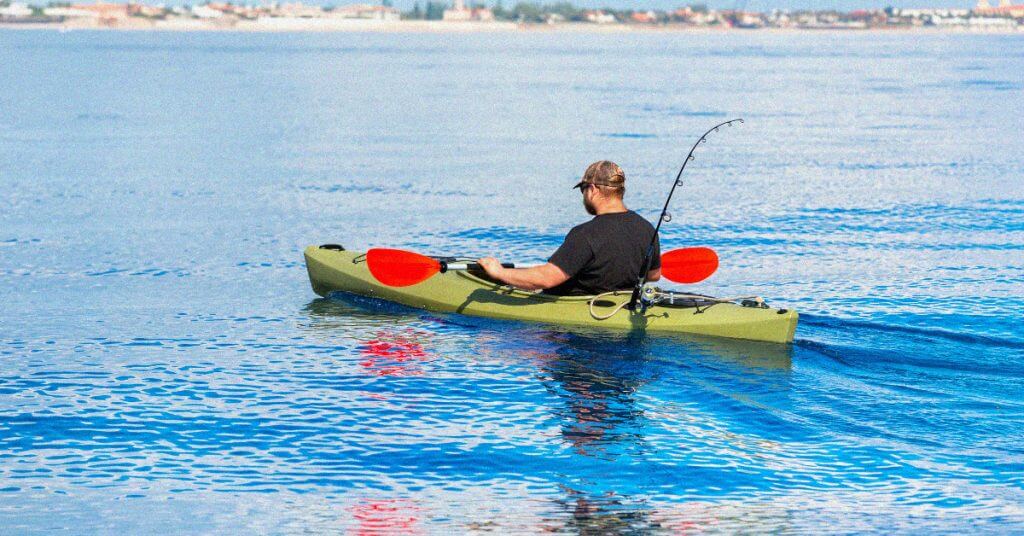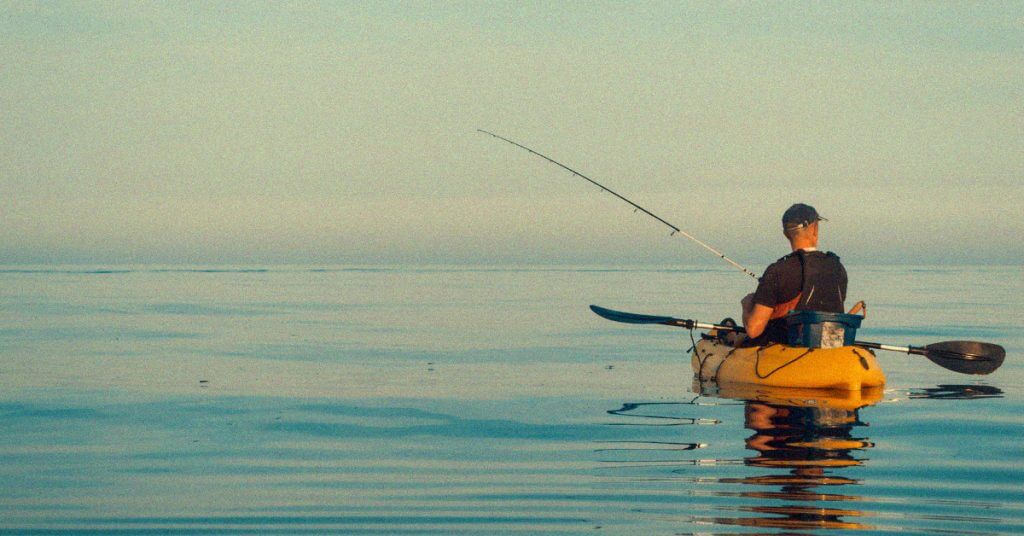It’s true you can fish out of any kayak. And I’ve done it.
However, many companies design kayaks with features specifically for fishing, but most fishing kayaks are extremely expensive.
That’s why I’ve tested the best fishing kayaks under $1,000. I’m not going to make you wait so you can get back to your hot date or find another way to avoid working.
The Brooklyn Kayak Company FK285 Angler 9’2″ Solo Sit-On-Top Kayak is the best fishing kayak under $1,000 because it’s designed with anglers in mind and it’s stable, which is great for beginners.
Now for the rest of the list, you’ll have to keep scrolling, but I promise it’s worth it!
Top 3 Fishing Kayaks Under $1,000
After rigorously testing many kayaks under $1,000, here are my top three worth buying if you plan to do lots of kayak fishing.
Table of Contents
Testing Procedures
I’ve paddled and fished from many different kayaks. While I’ve found the comfort, customizability, and stability of expensive fishing kayaks to be my preference; I understand the need for a budget-friendly fishing kayak.
Since price is our main concern, we will have to sacrifice a little customizability, comfort, stability, or design.
However, I was pleasantly surprised to find several fishing kayaks under $1,000 that I would happily take out on the water again.
- Price: I tried to keep the price of all these kayaks below or at $1,000. However, fishing kayaks are on the higher end of kayaks, so this wasn’t always possible.
Don’t worry; if your budget is strictly $1,000, there are kayaks on this list for you.
- Stability: This is a safety and comfort concern. As anglers, we have to lean over the edge of the kayak a lot, so you’ll need one that is very stable and doesn’t flip every time you lean over to grab your fish or get your lure unstuck, which is usually what I’m doing…
- Customizability: Every angler has a unique style of fishing and a preference for where their gear goes. Having a fishing kayak that I can adjust to fit my preferences is what I always look for when buying a new kayak.
- Comfort: As much as I love fishing, if I’m uncomfortable, I’ll end my trip early, so I always look for a comfortable seat and the ability to stand and stretch my legs.
Since there are products like a Kayak Kushion which you can add to your seat; this might not be such an emphasis.
- Design: While I’ve fished out of many kayaks that weren’t designed for fishing, I prefer to use fishing kayaks; it’s not even close. The additional features you get from a kayak designed for anglers are always worth the extra cost.
BEST FISHING KAYAK UNDER $1,000
BKC FK285 Angler 9’1″ Solo Sit-On-Top Kayak
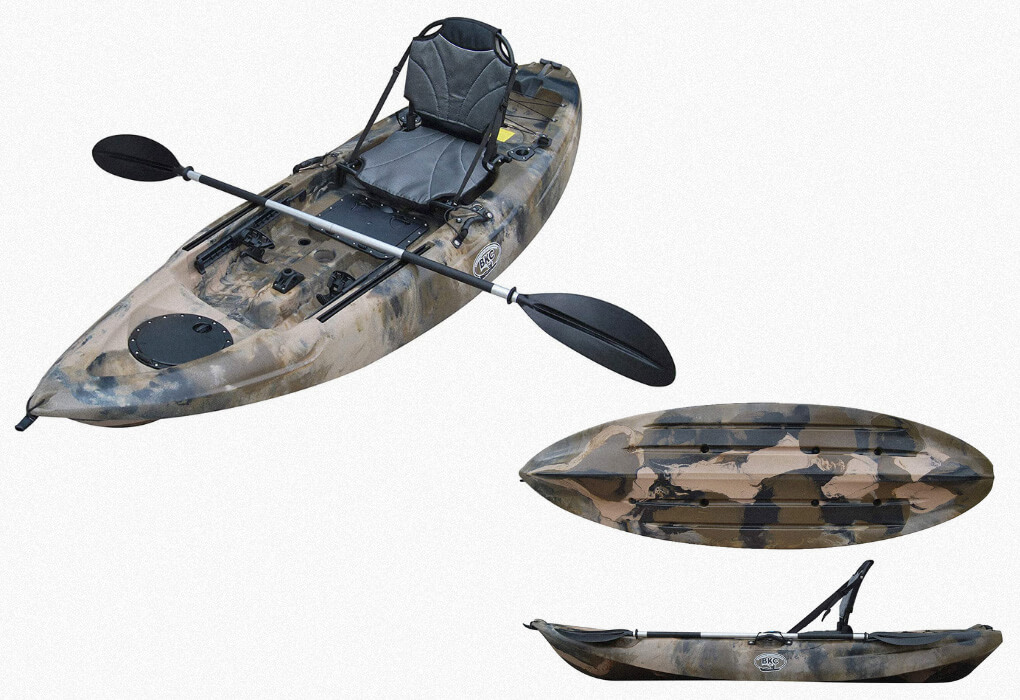
Specs
- Length: 9′ 1″
- Width: 32″
- Weight: 50lbs
- Weight Capacity: 350lbs
Pros
Cons
Why We Chose It
The Brooklyn Kayak Company FK285 is the best way to introduce someone to kayak fishing.
It has many features that high-end kayaks offer, like built-in rod holders, dry storage, and increased stability but at a beginner-friendly price.
I couldn’t believe this yak wasn’t more expensive when I tested it out! I NEVER once felt like I was going to tip while paddling and leaning over the edge.
I was also very impressed with how easily it paddled; with only minor adjustments, I was quickly lined up for my next cast, and I wasn’t worn out when I had to paddle it a little way to my honey hole.
The adjustable padded seat might not be top of mind for new kayak anglers, but you’ll thank me for recommending it after a long day of fishing, and your hind end ain’t sore!
You can adjust it for easier paddling, casting, and overall comfortability!
I was surprised that it was stable enough to stand up and fish from; however, the low seat height made it a little challenging to get to my feet, especially in rough waters.
I found there to be plenty of storage for my fishing gear, with two built-in rod holders and a bungee tank well to hold your kayak tackle boxes.
You can easily access the dry storage compartments at the front of the kayak and below your legs.
While this is the best fishing kayak under $1,000, it still has a few flaws, like the low seat height, limited customizability, and lack of a place to mount a kayak trolling motor.
Let’s start with the low seat height, I already mentioned it makes standing more difficult, but it is also less comfortable to sit like that for long periods of time. I find high-sitting kayak seats much more comfortable.
The next con is the lack of customizability. There are only two gear tracks, but they are large enough to hold multiple rod holders or a fish finder without them getting in the way of your fishing and paddling.
I’m just used to my Nucanoe Unlimited, which has front-to-back accessory tracks.
Most kayak anglers never mount a trolling motor, so this con really isn’t that big of a deal, but I like having the option to mount a trolling motor or a Power Pole Micro.
I can honestly say those two accessories have helped me catch more fish.
The BKC FK285 is the best fishing kayak for under $1,000 on Amazon because it’s super stable, designed for fishing, and reasonably comfortable, all at an affordable price.
You won’t find a better kayak in this price range, so go ahead and order one today!
BEST STAND-UP KAYAK UNDER $1,000
Ascend 12T Sit-On-Top Kayak

Specs
- Length: 12′
- Width: 31″
- Weight: 77 pounds
- Weight Capacity: 350 pounds
Pros
Cons
Why We Chose It
The Ascend 12T Sit-On-Top Kayak is the best stand-up fishing kayak under $1,000 because it’s comfortable, stable, durable, and designed for fishing.
It has all the features you need to walk on water, even if you’re on a tight budget.
The padded adjustable seat and footrests kept me comfortable while seated, and the non-skid foam padded deck was easy on my knees and feet as I stood and fished.
To be the best stand-up kayak, it better be stable, and with a 31” width and the custom tunnel hull design, this kayak gave me a platform to stand and fish from.
I didn’t ever feel like I was tipping; instead, I felt like I was walking on water!
Because it’s rotomolded plastic instead of Thermo-molded, it will last you many more years of fishing adventures, so you won’t have to worry about buying another one next year.
I only buy rotomolded kayaks even though they’re more expensive.
The biggest design flaw is the low seat height, which made standing a little more challenging than it needed to be; however, the kayak was plenty stable when casting, reeling, and setting the hook once I was standing.
While this kayak is customizable because of the gear tracks, it’s very limited. You can add more rod holders or a fish finder to increase your chances of finding fish but don’t expect to customize this kayak as the pros do.
There is also limited dry storage, but the bungee storage areas are large at the front and back of the yak.
The Ascend 12T is the best stand-up kayak for under $1,000. Better kayaks exist, but they cost well over $1,000. This is a great kayak for those just dipping their toes into kayak fishing.
So if that’s you, what are you waiting for? Order yours today!
BEST PEDAL KAYAK UNDER $1,000
Pelican Premium Getaway 110 HDII
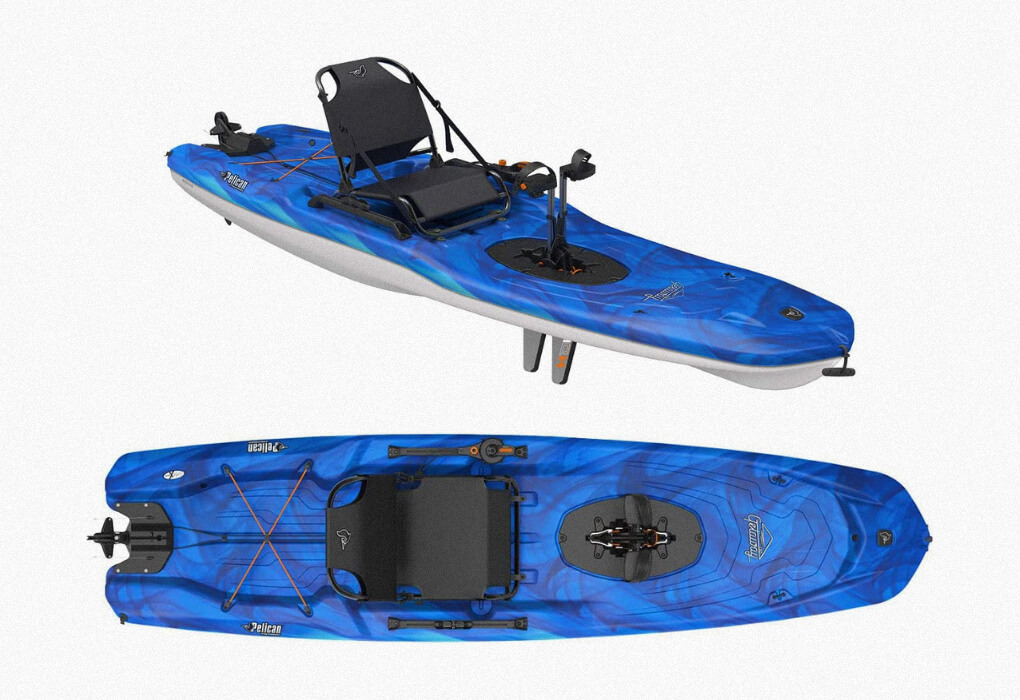
Specs
- Length: 10′ 5″
- Width: 33″
- Weight: 59 lbs
- Weight Capacity: 300 lbs
Pros
Cons
Why We Chose It
It’s nearly impossible to find pedal-drive kayaks under $1,000. The Pelican Premium Getaway 110 HDII is one of the few. Pedal kayaks have taken fishing by storm because you can get to your spot quicker and less tired.
They also give you more control over your kayak in the wind.
I love having options and having the option to paddle or pedal is a tremendous advantage while fishing. Instead of taking one or both hands off your kayak fishing rod to paddle, you can pedal to adjust your position.
And I like using the rudder system for not only pedaling but also paddling by helping me stay in line with my casts.
The ERGOCAST XP seating system is adjustable and fairly comfortable, though it was a little low for my preferences. The adjustability is only for how far you wish to lean back or forward.
So if you’re short like me, you’ll have to sit up pretty straight to reach the pedals, whereas taller folks will have to lean the seat back to remain comfortable.
Since you’re getting the considerable advantage of pedal power, there are several disadvantages this kayak has when fishing.
The first is that it was not designed for fishing; it lacks rod holders and gear tracks to add rod holders or a fish finder.
You’ll have to drill holes to mount a rod holder, and I hate drilling holes in my kayak. That’s just another place water will sneak into the hull.
The Pelican Catch Mode 110 is designed for fishing, but it’s not a pedal drive, so you’ll have to choose which is more important to you.
The lack of dry storage is also a bummer, but most kayak anglers can do without it. The tank well offers a little storage space with a bungee to hold your gear in place, but I wouldn’t put anything too valuable there.
The reason this yak is so inexpensive is that it’s thermo molded, so it’s more likely to crack where they joined the two pieces of plastic.
While the Pelican Premium Getaway 110 HDII is less than ideal for fishing, it’s impossible to beat the pedal drive capabilities at this price point. If you’re interested in a cheap pedal kayak, this kayak is perfect for you!
BEST SIT-ON-TOP FISHING KAYAK UNDER $1,000
Old Town Topwater 106

Specs
- Length: 10 feet 6 inches
- Width: 34.5 inches
- Weight: 75 pounds
- Weight Capacity: 440 pounds
Pros
Cons
Why We Chose It
The Old Town Topwater 106 is the best sit-on-top fishing kayak under $1,000 because it’s made by one of the most recognizable names in the industry, the seat is ridiculously comfortable, and you can stand up to fish.
Old Town is one of the most trusted names in the kayaking space. Many of their kayaks cost well over $1,000, so it’s more than worth it when you can get your hands on one that costs less.
The Old Town Sportsman 106 is the older model of the Old Town Topwater 106, but they’re virtually the same kayak; the main difference is the seat material.
The Topwater 106 is all-mesh seating, while the Sportsman 106 has some foam padding.
Both seats are very comfortable and adjustable. I prefer the mesh because it breathes more, so I sweat less, but my parents fish for hours in their padded seats without any complaints.
If, however, you need to stand, this kayak is more than stable enough to stand to stretch your legs and fish. I didn’t feel unsafe or like I was going to tip while testing it on a calm day at the lake.
I like that the Topwater 106 was designed for kayak fishing. It has flush-mounted rod holders and plenty of storage for an all-day-long fishing trip.
Plus, the gear tracks mean you can add other accessories to customize it to your fishing style.
The worst part about this kayak is the weight. It’s cumbersome for a kayak of this size, making loading and unloading more difficult.
It is manageable with one person and the way they designed the handles, but having an extra pair of hands to help load it on a roof rack is ideal.
It’s also slightly more than $1,000, so if you’re on a strict budget, this isn’t the kayak for you, even though I think it’s more than worth it.
I also tested the Jackson Kayak Bite Angler the same day I tested the Topwater 106 on calm waters. It’s slightly less expensive, but it also doesn’t have some of the features the Topwater 106 has, but it’ll help you stay within budget.
While the Old Town Topwater 106 has a couple of cons, it’s made by one of the most trusted names in kayaks, so I wouldn’t hesitate to buy the best sit-on-top kayak fishing kayak for under $1,000.
My parents love their Old Town Sportsman 106 PDLs, which is the pedal version of the Sportsman 106.
MOST STABLE BUDGET FISHING KAYAK
Perception Pescador 12
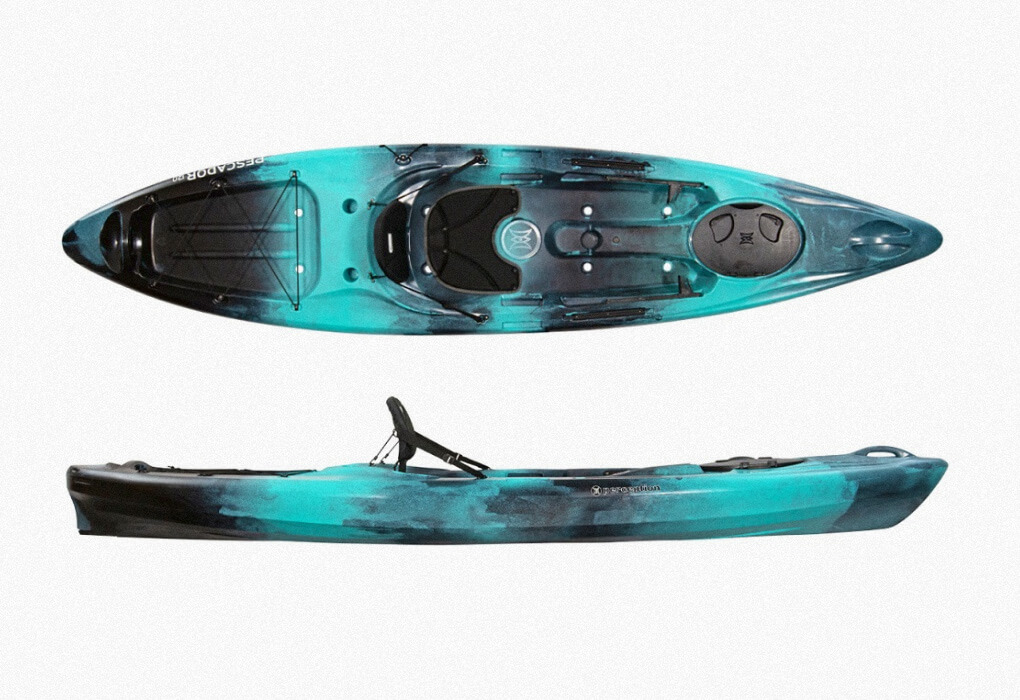
Specs
- Length: 12ft
- Width: 32.5in
- Weight: 64lbs
- Weight Capacity: 375lbs
Pros
Cons
Why We Chose It
The Perception Pescador 12 is an excellent fishing kayak for beginners because of its stability, storage options, and price.
Perception is known for crafting high-quality rotomolded kayaks at an affordable price, which is why I had to include at least one of their kayaks in my top picks.
The flat hull design aids in the stability of the Perception Pescador 12, which is one reason why I rated this as one of the most stable fishing kayaks under $1,000.
Since this kayak is 12 feet long, you’ll have plenty of room to stretch out and relax unless you’re the giant Goliath. That also means there’s plenty of storage.
Even with your tackle boxes secured by bungee cords, you will have plenty of room to enjoy a day of fishing.
The dry storage hatch is nice for keeping things like your phone, wallet, and keys dry and secure if you were to flip or have a rouge wave crash over the top of your kayak in rough waters.
While I didn’t stand in it and fish, I also didn’t feel unsafe or like I was going to tip. For a budget kayak, it was very stable.
Being a budget-friendly fishing kayak, there are a few compromises that must be made.
I found the seat to be too low and uncomfortable, even though the adjustable foot braces slightly helped counteract that problem.
The Wilderness Systems Tarpon 105 had a slightly more comfortable seat at a similar price and a few more features.
I also didn’t like that the short gear tracks limit your options to mount a fish finder or other kayak accessories, but it has flush-mounted fishing rod holders. Giving you a place to put a couple of rods directly behind the seat.
The Perception Pescador 12 is the most stable budget fishing kayak because it’s not tippy, holds all your gear, and was designed with anglers in mind.
If you need a cheap fishing kayak, that’s durable and has plenty of room, the Perception Pescador 12 is the kayak for you. The Perception Pescador Pro 12 is another step up in fishing features and price.
Buyer’s Guide: Factors To Consider Before Buying The Best Kayak Under $1,000
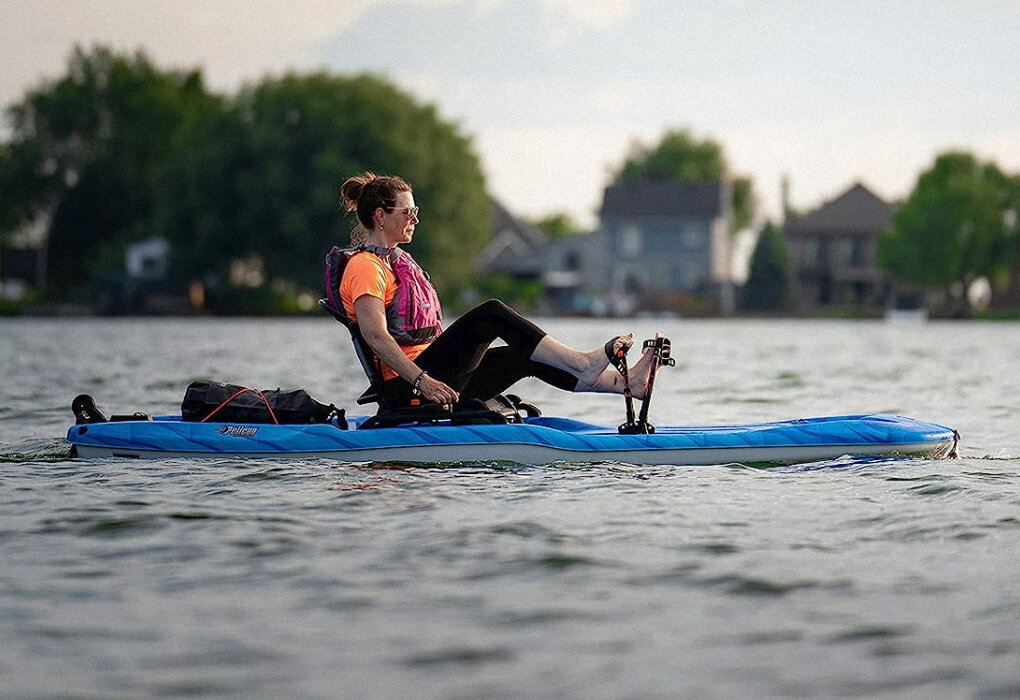
Kayaks have a wide price range, and fishing kayaks tend to be on the higher end of that spectrum.
With many kayaks exceeding $2,000, one might think there’s no way a fishing kayak will cost less than $1,000, but a few are sold below this price.
However, you must be willing to compromise some kayak features.
Some features are necessary to improve your fishing experience, and others are nice luxuries. It’s up to you to decide what matters most to you.
I’ve taken the liberty to list several essential factors while on the water kayak fishing. Keeping these in mind while buying a kayak will help you make a better purchase:
- Length
- Weight Capacity
- Stability
- Customizability
- Manufacturing process
- And the type of kayak
Length
The length of the kayak not only determines the amount of storage you have on top but also factors into how well the kayak tracks.
This means how well the kayak will go in a straight line when paddling. The length also factors into how you will transport the kayak and how well it handles different waterways.
A shorter kayak will turn quicker than a longer kayak, so a short kayak (9′-10′) is best for fishing in freshwater ponds, creeks, and rivers.
A longer kayak (12’+) will track better, so they’re best in lakes, rough waters, and the ocean. If you’re a saltwater angler, you should check out my top pick for ocean fishing kayaks.
With that said, I use my 12′ kayak in local rivers, so this is a general rule.
Maximum Weight Capacity
Every kayak has a different maximum weight capacity. Factor in your weight and the weight of the gear you want to bring, and stay well below the maximum amount.
The closer you get to the weight capacity, the less stable it becomes.
A tandem fishing kayak tends to have a higher weight capacity to compensate for two paddlers. However, these kayaks rarely cost less than $1,000.
Stability
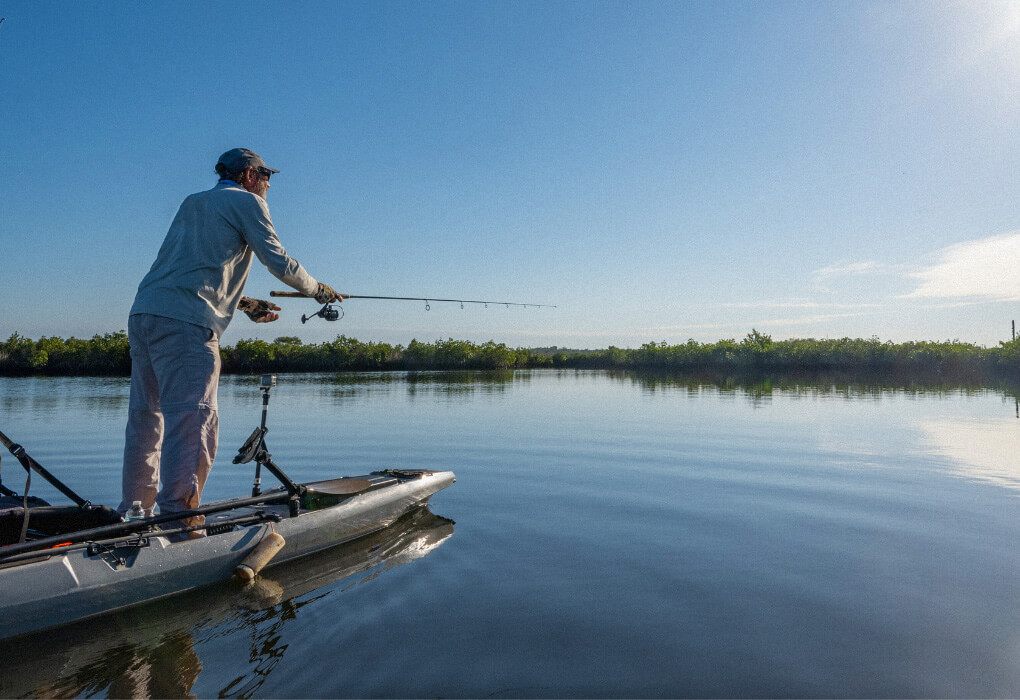
The most important feature of any fishing kayak is stability. I like to stand and fish from my kayak to stretch my legs and get a better look at what’s in the water.
I wouldn’t be able to do this if I didn’t have a stable kayak. I’ve found that most fishing kayaks are relatively stable because they are generally wider than recreational kayaks.
If you don’t have a stable kayak, you can improve the stability with the best kayak outriggers. Stability is a safety issue, so don’t overlook it.
Customization
Every angler has a unique style of fishing. It’s nice to have a kayak that can adapt to your style instead of trying to adapt to the kayak because you already have to adjust to a new way of fishing.
If you’re having difficulty adapting to fishing from a kayak, here are 10 of my best kayak fishing tips for beginners.
I prefer to have a clear deck while other kayak anglers cram as much gear onto their kayak as possible. The gear tracks on a fishing kayak allow the angler to choose where rod holders and fish finders go.
I like to have as many gear tracks as possible so I have more options.
Manufacturing Process
The manufacturing process and materials will determine the quality of your fishing kayak. A rotomolded kayak will be more durable than a thermoformed kayak. However, a thermoformed kayak will be less expensive.
A rotomolded kayak is one solid piece of plastic or PVC. The liquid plastic is poured into a mold and slowly rotated. Once it’s cooled and hardened, the mold is removed.
The handles and other hardware are then installed. This process eliminates seams in the plastic. Therefore, it’s more durable.
A thermoformed kayak is two pieces of plastic “melted” together. A top and bottom mold is made, and the plastic is poured into each.
Once it hardens, the top is placed on the bottom, combined, and sealed. This process leaves a seam that is prone to eventually separate.
Sit-In Vs. Sit-On-Top
Most fishing kayaks are sit-on-top kayaks because they allow the angler more room for angling activities. That doesn’t mean you can’t find an excellent sit-in fishing kayak.
My dad used a sit-in fishing kayak for years before upgrading to a sit-on-top.
A sit-on-top allows you to sit higher to see into the water better. It also makes getting to your storage and standing easier. The seats are typically more comfortable on a sit-on-top kayak.
The list goes on and on as to why a sit-in kayak doesn’t match up to a sit-on-top.
However, a sit-in kayak is cheaper than a sit-on-top kayak of the same quality. Unless you plan to become a tournament kayak angler, a sit-in fishing kayak is a good beginner’s kayak.
Inflatable Fishing Kayak Vs. High-Density Polyethylene
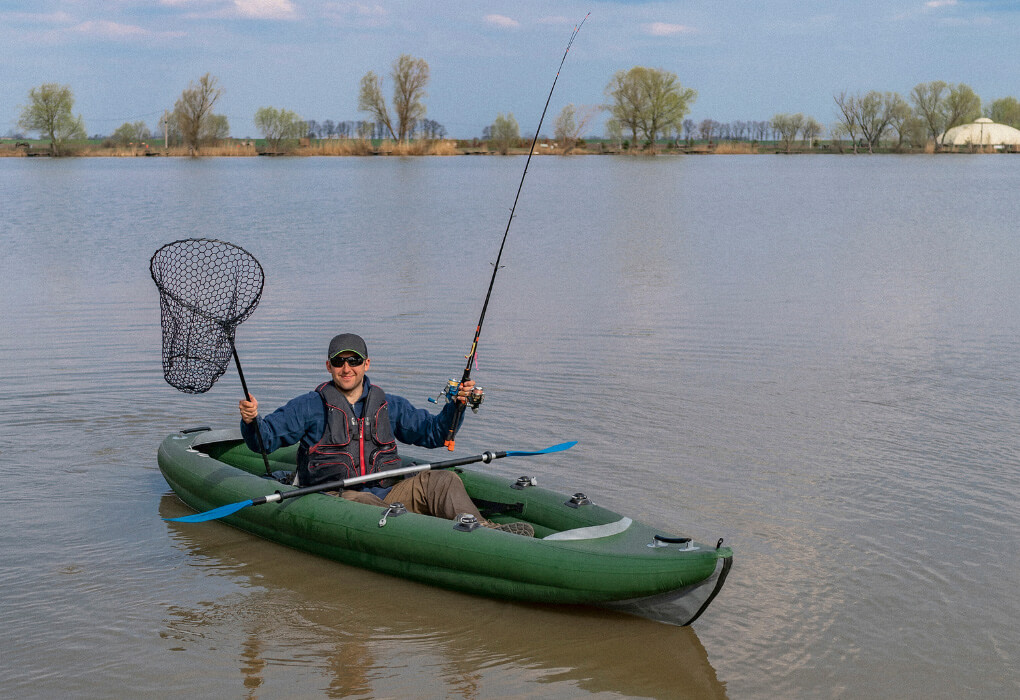
I believe polyethylene kayaks are superior to inflatable kayaks. If you disagree, then answer me this, why do all professional kayak anglers use polyethylene kayaks?
With that being said, I know we’re not all professional kayak anglers, so I understand sometimes inflatable fishing kayaks make more sense.
You should use an inflatable fishing kayak when you don’t have a way to transport or store a plastic kayak, need a lightweight kayak, or need the extra stability and weight capacity inflatable kayaks provide.
Inflatable kayaks are often less expensive than plastic kayaks. However, they are also more work and require more maintenance.
Most polyethylene kayaks have minor features like cup holders and carrying handles that many inflatable kayaks don’t have. They are also more abrasion-resistant.
Both are typically UV-protected but shouldn’t be stored in direct sunlight.
You’ll Also Need
Buying a fishing kayak is only the first of many purchases you’ll need to make to safely and effectively catch fish from your kayak. You will also need many of the following items.
Not all of these items are necessary to begin kayak fishing, but some are vital:
- PFD
- Paddle
- Tackle Boxes
- Fishing rods and reels
The other less important but beneficial items are:
- Fish finder
- Trolling motor
- Trolling motor battery
Kayak Fishing PFD

Honestly, you should buy a life jacket before you purchase a kayak. A Personal Flotation Device will keep you floating in case of an accident.
I’ve heard too many sad stories of anglers choosing not to wear a lifejacket who fall in and don’t return home to their families.
ALWAYS wear a PFD.
I’m a reasonably strong swimmer, but I put my lifevest on as I leave the shore and don’t take it off until I’m back on land.
If you need a kayak fishing life jacket, you should check out my best kayak fishing PFD article so you can stay safe while fishing.
Kayak Paddle
I have two motors for my kayak, one trolling motor and one small outboard motor. I ALWAYS have my paddle with me. It has saved me on more than one occasion.
On one occasion, I ran out of battery in my trolling motor and had to paddle back to the ramp.
My outboard motor died and wouldn’t start on another, so I had to paddle a few miles to my take-out spot.
I was thankful I had my paddle for both occasions. There are different sizes and styles of paddles. To determine the correct size, you’ll need to factor in your height and the width of your kayak.
The style is your choice. They make paddles specifically designed for fishing but are not necessary to be a successful kayak angler.
Kayak Fishing Tackle Boxes

It’s true you can use any tackle box while kayak fishing, but some make fishing from a kayak much more enjoyable. You can find out which one is the best kayak tackle box by following the link.
I prefer a compact box that can hold everything I should need for a day on the water.
I don’t like making things any more complicated than they need to be, so my kayak tackle management is simple.
I keep most of my gear in large boxes stored in a tote in my truck and then take a couple of boxes out on the water with only the lures I think I’ll need. Most of the time, this works perfectly for my fishing adventure.
Kayak Fishing Rods
I still use the same rods for kayak fishing as I do for bank and bass boat fishing. However, I’ve slowly replaced these rods with more kayak-friendly rods as they break.
You can see the best kayak fishing rod in my article, but remember, you don’t have to go out and buy all new rods and reels.
Start with what you have and slowly upgrade over time.
Kayak Fish Finder
One of the best non-essential additions to my kayak was my fish finder. I went with the best value Garmin Striker 4, but any of the fish finders in our best kayak fish finder article will be adequate.
Having a fish finder lets you see the water temperature, the contour of the bottom, and the water depth; it also allows you to see fish, depending on the transducer you purchase.
Kayak Trolling Motor
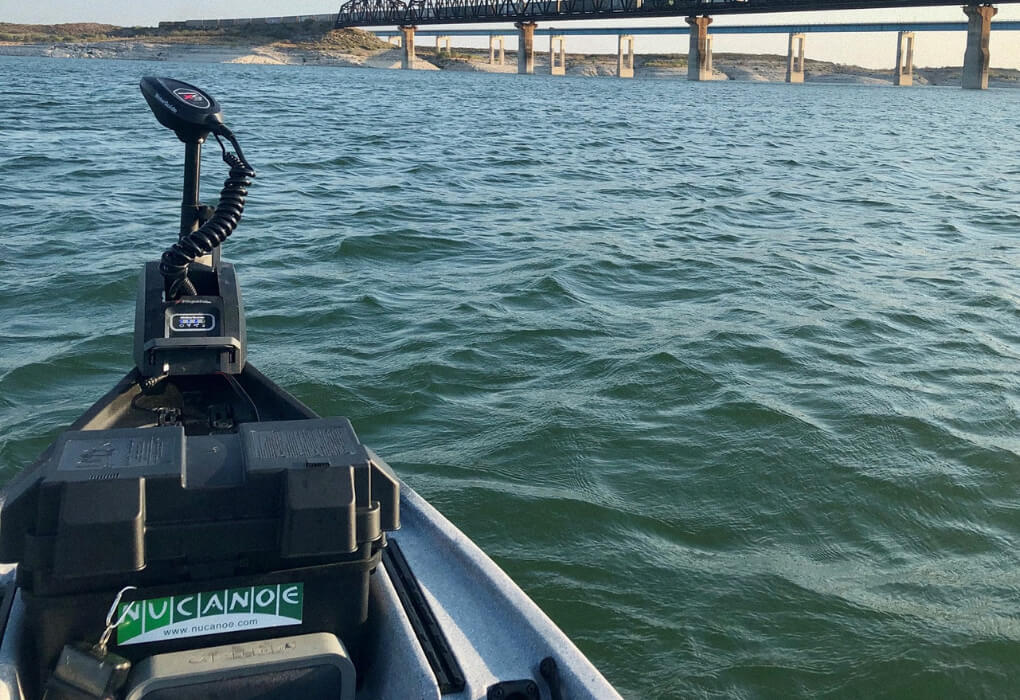
Another intelligent purchase was my trolling motor. By installing my trolling motor on my kayak, I instantly gained more speed and control of my kayak.
I was no longer worn out from paddling to my favorite spots or against the wind.
You can see the 10 best kayak trolling motors on the market today to help you choose the one that best suits your needs.
Kayak Trolling Motor Battery
To operate sonar and a trolling motor, you’ll need a battery. Thankfully, I made a list of the best kayak trolling motor batteries to help get you started in the right direction.
I recommend Lithium-Ion batteries because they are longer-lasting, more powerful, and weigh less than Lead-Acid batteries.
Frequently Asked Questions
I’ve taken the liberty to answer some of the most commonly asked questions about fishing kayaks under $1,000.
What are the advantages of a fishing kayak?
The advantages of a fishing kayak are it has fishing accessories, like rod holders built-in, and it’s more stable and more comfortable.
What is the main body material of the kayak?
The main body material of a kayak is generally plastic (polyethylene), thermoformed ABS-acrylic, fiberglass, or Aramid (Kevlar).
Some kayaks are even made from wood, but they’re typically very expensive.
What are the benefits of a sit-on-top kayak?
The benefits of a sit-on-top kayak are more comfortable, easier to see into the water, easier casting and fighting a fish, and more stability.
One More Cast
While fishing kayaks are expensive, you can find a quality kayak on a small budget, leaving you more money to splurge on fishing tackle!
The BKC FK285 Angler Kayak is the best fishing kayak under $1,000 because it’s stable, designed for fishing, and actually costs less than $1,000!
Finding a pedal kayak for under $1,000 is rare, but the Pelican Premium Getaway 110 HDII barely met the mark before tax. However, it’s not designed for fishing.
If you’re searching for the best fishing kayak under $1,000, drop your questions in the comments!

